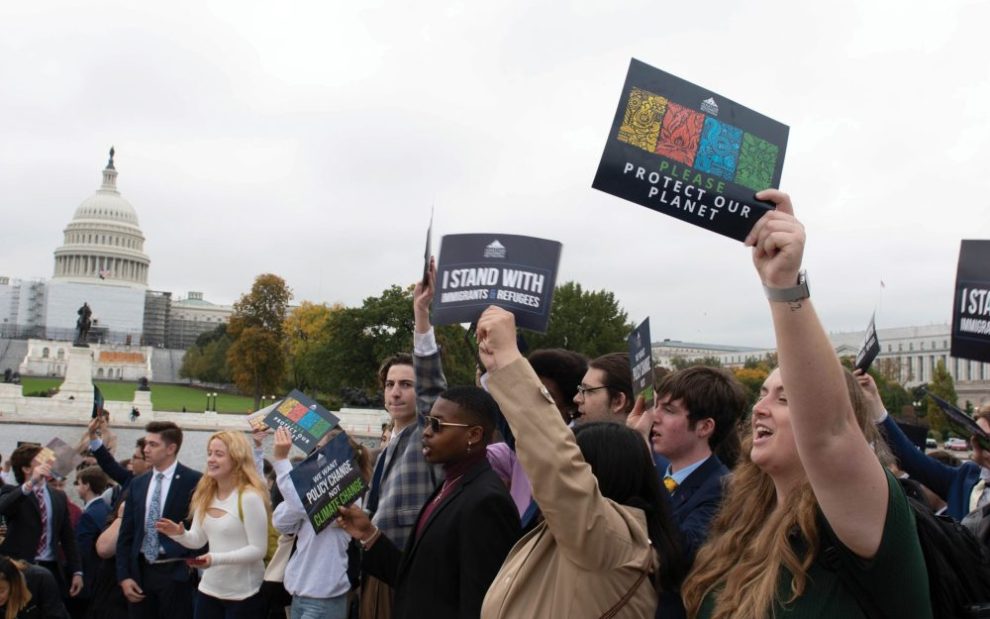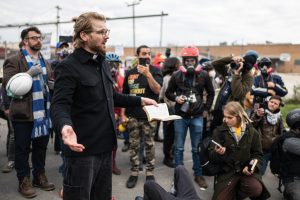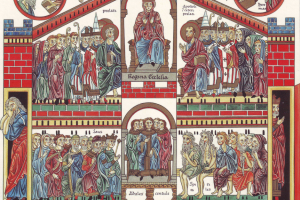One weekend each fall, some 2,000 high school students from Jesuit schools around the country descend on the Washington, D.C. area to talk about immigrants, people experiencing poverty, the LGBTQ community, and anyone who is marginalized. They listen to those who have done something about social disparities in the world. They pray, take part in the Eucharist, sing, then act.
Sometimes the students head to the Washington offices of the lawmakers who represent their home states in Congress. The students, driven by their faith beliefs, present their arguments in favor of certain legislative actions to the lawmakers or congressional staff.
Sometimes they take part in public demonstrations, giving personal testimony of how certain laws—or lack of them—affect them, their families, their communities, or their peers.
“They see things in the world, recognize injustice and unfairness,” and want to do something about them, says Christopher Kerr, executive director of Ignatian Solidarity Network, which organizes the event.
The Ignatian Family Teach-In is part of what organizers hope will be the beginning of a life of service and advocacy for the young Catholic school students. For some, that path began with volunteer work and service projects, helping disadvantaged communities near or at the Catholic schools and parishes they attend.
Catholic schools and parishes require their students to volunteer as part of their education or before their confirmation.
“In the past few generations, our Catholic Church has done an outstanding job with making sure that service projects are included in our high school and confirmation programs,” says Bishop Ronald Hicks of the Diocese of Joliet, Illinois. “I think that’s wonderful, but maybe what we need to improve on is helping our children and young people understand why they’re doing the service.”
Our ‘best-kept secret’
At the Shrine of the Sacred Heart, a predominantly immigrant parish in Washington, D.C., Monica Zevallos, the Rite of Christian Initiation of Adults (RCIA) coordinator, says it can be tricky working with Spanish-speaking young Catholics. Some students, particularly recent immigrants, deeply connect with certain service projects, perhaps because they can identify with people who are struggling, she notes. But other young Catholics sometimes see service work as a chore, another thing to check off a list.
“You have to teach them how to approach [service] from a [Catholic] social teaching point of view, a Christian view,” she says. To do that, you have to first introduce young people to the face of Christ in a vulnerable person.
At the Shrine of the Sacred Heart, that’s not too difficult to do. The parish, located in a working-class neighborhood, regularly serves meals in the church basement or on the sidewalk to people who are experiencing homelessness or who struggle with addictions and other forms of poverty.
Teenagers, Zevallos says, can sometimes have visceral reactions to how people act or smell, so it’s important to walk them through what they may experience during their service work, which for some may be their first interaction with vulnerable people.
It’s important to help teenagers reflect on whom and what they’ve encountered, ask them what they know about the people before them, and take them down a path toward the work of justice, adds Kerr.
“Maybe what we need to improve on is helping our children and young people understand why they’re doing the service.” Bishop Ronald Hicks
However, putting a person’s struggles in a social context is something the church doesn’t always do well, Kerr admits. Some students may simply go in and check off service hours from a list for confirmation or school. When they do so, an important moment in their Christian formation is lost.
Kerr says he has “become uncomfortable” with the popular saying in social justice circles that Catholic social teaching is the church’s “best-kept secret.”
“It shouldn’t be,” he says. “If we’re truly committed, we have to help young people move from volunteer work to justice.”
For the young Catholics with whom he works, that leads them toward a path of lifelong service and fulfilling the kingdom of God, from small acts such as serving a meal to large-scale ones that change systems and structures that oppress the vulnerable.
“If we do that, we’ll find that Catholic social teaching isn’t the best-kept secret. It’s the gospel in everyday life,” Kerr says.
And it’s something that engages and challenges the younger generations. Kerr points out that each year the Ignatian Family Teach-In, now in its 25th year, grows in attendance and complexity of topics while also allowing students to talk about the injustices they have suffered from oppressive systems.
The idea of service expands from an interaction with a person suffering to advocacy for changing a system that contributes to suffering.
In November 2021 Darian Benitez Sanchez, who had attended Brophy College Preparatory Catholic high school in Phoenix and was a beneficiary of a policy aimed at helping young adults brought into the United States as children, was a featured speaker at a demonstration near the U.S. Capitol.
He talked about how his family had crossed the U.S.–Mexico border without legal permission. He spoke of his father’s sadness when his mother was detained by immigration authorities. He shared how his father, fearing he would run into immigration officials, regularly sat in his car waiting while Benitez attended academic competitions.
Nearby, as he spoke, the young man’s peers held signs that read, “I stand with immigrants and refugees.”
Another student spoke of how he’d participated in a hunger strike in front of the White House to call attention to climate change. He remembered Indigenous people who were cruelly hosed down by authorities in freezing weather as they protested the construction of the Dakota Access pipeline near the Standing Rock Indian Reservation, between North and South Dakota, in 2016.
The students spent the weekend talking about the Black Lives Matter movement, climate change, immigration, and the need to support their LGBTQ peers.
“Young people desperately want the church to live up to the values the gospel calls us to.” Christopher Kerr
Near to all those actions, those injustices, Kerr says, is the memory of the suffering they see in their homes and communities or in the news. In them they see the image of the wounded Jesus on the cross.
“They see other people in that narrative and recognize they can be part of that narrative. They can be part of resurrection day,” Kerr says. “Young people desperately want the church to live up to the values the gospel calls us to.”
‘A disconnect’
Sometimes students’ experience of service work at a school or parish can seem detached from the suffering of the world and the daily injustices young Catholics see affecting their lives, their peers, or the vulnerable.
Sometimes there’s a disconnect, a miscommunication between what the church hierarchy and students see as actions to make the world better, Kerr says.
“On issues of racism in our society, there is definitely a disconnect, when they see or don’t see the church engage in these issues,” he says.
Take the Black Lives Matter movement, for example, he adds.
In June 2020, Bishop Thomas Daly of the Diocese of Spokane, Washington spoke against Black Lives Matter. He stated it was “in conflict with church teaching” and against family, marriage, and the sanctity of life. Other bishops, but not all, followed his lead.
In El Paso, Texas, however, Bishop Mark Seitz, along with other priests from his diocese, kneeled in a public park as the prelate held a Black Lives Matter sign, acknowledging the disparity and suffering of Black Americans.
Some church leaders, such as Daly, see Black Lives Matter as an organization. But young people see Black Lives Matter as a movement that protests the unjustified fatal shootings of Black people by police and the systemic injustices they suffer, Kerr says.
Many young Catholics who participated in the Black Lives Matter protests that were rampant in 2020, for example, see it as a movement, “as ‘Black lives matter,’ lowercase,” Kerr says. When church leaders speak out against it but insist the Catholic Church stands for human dignity, “it becomes a disconnect,” he adds.
Church leadership also hasn’t kept up with methods of communication that young Catholics, like others of their generation, look to and engage with in what they see as matters of injustice. While church hierarchy may point to a document spelling out the stance of the church on those matters, young Catholics absorb information differently—on their phones through TikTok or other social media platforms.
“They’re not reading the bishops’ statement on racism. They’re watching a video of a person being berated by police officers,” Kerr says.
Similarly, as some young Catholics are against the marginalization of LGBTQ community members, they also hear church leaders openly denigrate or condemn members of that community. Sometimes church leaders don’t talk about them at all in the context of parish life, Kerr says.
“It’s really challenging to apply the gospel to the world today. It takes moral boldness. I don’t know that you’re going to get young people’s attention if you don’t do that,” he adds.
“Catholic social teaching isn’t the best-kept secret. It’s the gospel in everyday life.” Christopher Kerr
Zevallos, however, says that it’s challenging to balance some issues the students see on social media and get excited about supporting with what the church teaches. Sometimes what church personnel want the students to do in order to teach them about service projects and what the young Catholics want to do can be at odds, she adds.
Young Catholics have a tendency to say, “If the church doesn’t give me what I want, I’m leaving,” she says.
For Hicks, what’s important is that those who instruct young Catholics—whether teachers at Catholic schools or parish personnel—make the connection for students between the church and the volunteer work, service project, or action being carried out.
“Basically, they need to know that the reason we go out and do good things for the poor, the marginalized, the vulnerable, the underprivileged, anyone in need, is because we love God,” he says. “Jesus specifically asks us to put our faith into action. Therefore, every time we are serving someone else, the least of our brothers and sisters, we’re doing it for Jesus.”
He says some in his diocese have asked whether they should reduce the service hours in Catholic high schools or confirmation programs.
“My answer is always the same: no,” he says. “They’re wonderful. . . . We simply have to intentionally make sure that our young people understand the connection [of service work] to our faith, to Jesus who asks us to put that faith into action.”
The way Kerr sees it, service work and its ability to actively engage young Catholics in church teaching is essential in keeping them as active Catholics, inside and outside of the church.
“Service work is unique,” he says. “It invites a young person to engage in-depth with the teachings of the church. That is unique.”
‘Active participants’
For those involved in events such as the Ignatian Family Teach-In, working toward understanding injustice, demanding a change of the systems that cause inequality in society, and looking at service from a humanitarian perspective are all related to the way six Jesuit priests lived their faith and how they were martyred because of it in El Salvador in 1989.
In November of that year, more than a dozen paramilitary soldiers who had trained at a U.S. military facility opened fire at close range on six Jesuit priests in the private residence of José Simeón Cañas Central American University in San Salvador where they served. They were brutally murdered, as were their housekeeper and her 16-year-old daughter. The clerics were found in the morning face down and still wearing their bloodied bathrobes.
Some of the Jesuits who were killed had been outspoken against the unfair structures in the country that kept poor civilians serving large-scale landowners and left no room for them or their children to advance. They also cried out against the violence unleashed on the poor by government military forces.
The incident moved Jesuits in the United States and those who supported them to action. They wanted the U.S. public to know how and why they had been murdered. They wanted the Jesuits’ deaths to mobilize others against unfair structural systems the slain priests had died for.
A small group gathered under a tent in Georgia to protest U.S. training of those who terrorized innocent civilians and had killed the Jesuits for their advocacy of the poor. That small gathering eventually evolved into the Ignatian Family Teach-In weekend for young Catholic school students so that they would continue the work of the slain Jesuits and learn to challenge the systems that oppress the poor.
In writing about Christus Vivit (Christ Is Alive), an apostolic exhortation directed at young Catholics by Pope Francis, Diana Hancharenko, a young adult minister at St. Angela Merici Church in Youngstown, Ohio, states in a July 2020 reflection for the U.S. Conference of Catholic Bishops (USCCB) that “if young adults see that their experiences or gifts don’t look like what they think a typical Church person should, or if they don’t have mentors or anyone to accompany them, they will often disqualify themselves, and either remain quiet and hidden or will simply walk away.”
“They’re not reading the bishops’ statement on racism. They’re watching a video of a person being berated by police officers.” Christopher Kerr
In the apostolic exhortation, Pope Francis points out that “Christian service represents a unique opportunity for growth and openness to God’s gifts of faith and charity. Many young people are attracted by the possibility of helping others, especially children and the poor. Often this service is the first step to a discovery or rediscovery of life in Christ and the Church.”
However, Pope Francis adds, “many young people grow weary of our programmes of doctrinal and spiritual formation, and at times demand a chance to be active participants in activities that benefit others.”
The USCCB’s 2020 document “Realities Facing Youth and Young Adults in the United States” shows some of the struggles in keeping young Catholics engaged in the church’s more ceremonial life. Yet it points out that young people are attracted to the social justice and advocacy work they find on “mission trips, [with] local outreach to those on the peripheries in the community,” and with different Catholic humanitarian organizations.
To do that, Kerr says, “takes a lot of work [and] staffing.” However, if there’s no deliberate attempt, there’s a risk in losing not just the good works of young Catholics but also their faith in a church founded on serving others. There’s an important message about the church that gets lost, Kerr says, “if we don’t form the heart through encounter and reflection,” something that young Catholics find in working with and for those on the margins of society.
Unfortunately, the COVID-19 pandemic, says Kerr, put a dent in a lot of those experiences when interaction in general became limited. The consequences of those limits still remain unknown.
“I think COVID-19 was challenging for this work, for service programs. Mission immersion trips were limited. That was a big barrier. Schools had to prioritize their classroom experience on Zoom,” he says.
But it also helped define the importance of physical encounter with people who are vulnerable and how it’s connected to those who want to “live out” Catholic social teaching, he adds.
For Hicks, the work of the church that begins with acts of service is part of an introduction to the DNA of the church, the first lessons Jesus taught, and an important lesson to learn during a Catholic’s formative years. It’s about a negation of the self, of giving of one’s time and talents for a better world.
“I think this is what we have in the church: We’ve all been given gifts. We’ve all been given blessings,” he says. “Some of us struggle in more ways than others, but [service] teaches us how we can . . . not only think of ourselves but think of the other, think of our brothers and sisters in need.”
This article also appears in the January 2023 issue of U.S. Catholic (Vol. 88, No. 1, pages 10-15). Click here to subscribe to the magazine.
Image: Courtesy of Ignatian Solidarity Network













Add comment